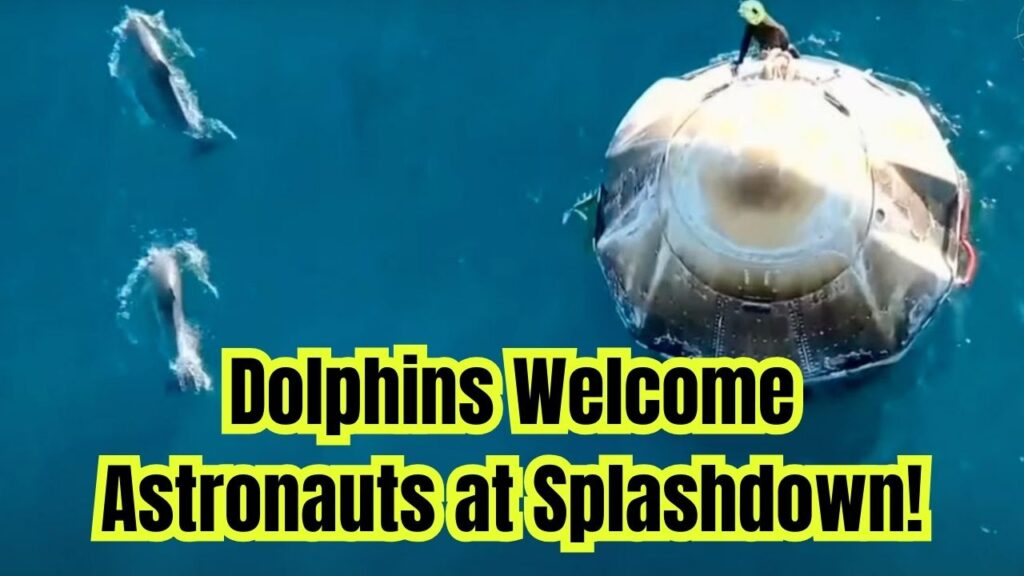
NASA astronauts Butch Wilmore and Suni Williams received an unexpected but delightful welcome back to Earth as they splashed down near the Florida coast in the Gulf of Mexico. After spending nine months aboard the International Space Station (ISS), their SpaceX Dragon capsule, Freedom, landed safely in the ocean—only to be surrounded by a pod of dolphins playfully greeting them.
The remarkable event, captured by drone footage and shared by NASA, has since gone viral, capturing the imagination of space and nature enthusiasts alike. The astronauts’ return marked the successful completion of a mission that was extended due to technical issues, making their homecoming all the more special.
Key Highlights
| Topic | Details |
|---|---|
| Astronauts | Butch Wilmore & Suni Williams |
| Mission Duration | 9 months (initially planned for a shorter stay) |
| Splashdown Location | Gulf of Mexico, near Florida coast |
| Spacecraft | SpaceX Dragon Freedom |
| Welcome Committee | Pod of dolphins seen surrounding the capsule |
| Mission Challenges | Extended stay due to technical delays |
| Recovery Site | NASA’s Johnson Space Center, Houston |
| Official Source | NASA.gov |
The Journey Back to Earth
1. The Mission & Its Unexpected Extension
NASA’s mission was initially planned to be a short-term stay, but due to technical concerns with their return spacecraft, Wilmore and Williams’ time aboard the ISS was extended to ensure a safe return. The astronauts continued to conduct valuable experiments, maintenance, and educational outreach while awaiting their return.
2. The Splashdown: A Picture-Perfect Landing
On March 18, 2025, at exactly 5:57 p.m. EDT, the SpaceX Dragon Freedom made a smooth re-entry and splashdown into the Gulf of Mexico. The recovery team was on standby, ready to retrieve the capsule and its crew. However, they weren’t the first to welcome the astronauts back—dolphins were seen joyfully swimming around the capsule, as if celebrating their return.
3. Dolphins and Their Unique Connection to Space Missions
It’s not the first time marine life has been spotted during a splashdown, but this particular moment stood out due to the dolphins’ active participation. Scientists have long observed dolphins’ curiosity toward unusual objects in the water, and this moment highlighted their intelligence and social nature.
What Happens After Splashdown?
Once back on Earth, astronauts undergo a 45-day rehabilitation program at NASA’s Johnson Space Center in Houston. After spending months in microgravity, the human body needs time to readjust to Earth’s gravity. The recovery process includes:
- Medical evaluations to check for muscle atrophy and bone density loss.
- Physical therapy to regain strength and balance.
- Scientific debriefings to discuss their findings and experiences.
- Public outreach events where they share their journey with the world.
Why Is This Mission Important?
This mission not only contributed to ongoing research on human spaceflight but also provided new insights into how extended stays in space affect the human body. NASA and SpaceX continue to refine re-entry and splashdown procedures to ensure future missions, including the upcoming Artemis moon missions, are as safe as possible.
The Role of Private Space Companies
SpaceX, a private aerospace company, has been instrumental in advancing space exploration with its reusable rockets and innovative spacecraft. This successful mission further strengthens the collaboration between NASA and private space enterprises, paving the way for longer and more ambitious spaceflights.
Future Space Missions and Technological Advancements
1. Lessons Learned from This Mission
The extended mission duration provided valuable data on long-term human spaceflight. These lessons will be crucial for upcoming missions to the Moon and Mars, helping scientists and engineers design better life-support systems and health monitoring tools.
2. The Future of SpaceX and NASA Collaborations
With successful missions like this, the partnership between NASA and SpaceX is expected to grow stronger. Upcoming Artemis missions will further rely on commercial partners to transport astronauts and cargo beyond Earth’s orbit.
3. The Evolution of Reusable Spacecraft
One of the biggest takeaways from the SpaceX Dragon capsule is its reusability. Unlike traditional capsules that are discarded after a single use, Dragon can be refurbished and reused for multiple missions, significantly cutting costs and making spaceflight more sustainable.
Frequently Asked Questions (FAQs)
1. Why do astronauts land in the ocean?
Water landings help cushion the impact compared to solid ground. The ocean provides a vast, open area with no obstacles, reducing the risk of injury or damage to the spacecraft.
2. How do astronauts prepare for re-entry?
Before re-entry, astronauts conduct a series of checks, including securing equipment, donning their protective suits, and monitoring spacecraft systems. They experience intense G-forces during descent, requiring extensive training beforehand.
3. Do dolphins always appear during splashdowns?
Not always, but dolphins are naturally curious creatures. Their appearance during this splashdown was likely due to their interest in the unusual disturbance in their environment.
4. What’s next for Wilmore and Williams?
After rehabilitation, they will share their experiences through public engagements and continue training for potential future missions.
5. How does microgravity affect the human body?
Microgravity can cause muscle atrophy, bone density loss, fluid redistribution, and changes in vision. Astronauts exercise regularly while in space to counteract these effects, but readjusting to Earth’s gravity still takes time after a long mission.
6. What role do private companies like SpaceX play in space exploration?
Private companies like SpaceX are essential for reducing costs and increasing access to space. They provide launch services, spacecraft, and innovative technologies that allow NASA to focus on deep-space exploration.










